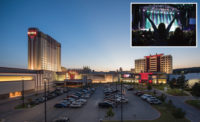Developing a High-Class Security Brand

Chief of Security and Transportation Jeff Karpovich stands outside one of the High Point University Welcome Centers, where a security officer meets and greets every person and vehicle coming onto the campus. Photo courtesy of Worth Canoy

In an effort to streamline both reservations for meeting rooms and access control, the Oregon State University’s College of Business integrated the two into a management platform to add value for students and faculty while saving time and resources for staff. Photo courtesy of Vanderbilt Industries

Every summer, the security team at High Point University completes a customer service module for professional development. Photo courtesy of Jeff Karpovich



I n North Carolina, High Point University is in its tenth year of a transition into a private, boutique university, and the security department is not exempt from the changes impacting the school. When Jeff Karpovich, CPP, CHPA, joined High Point University as its chief of Security, there were just 12 employees in the division and 62 surveillance cameras. Now, seven years later, he is responsible for 120 employees across three departments, managing 82 uniformed security officers for the school and working with approximately 900 surveillance cameras.
“Our expanded security department is not a reaction to any incident, but it’s part of an effort to prevent those incidents in the first place,” says Karpovich, Chief of Security and Transportation at High Point University.
The security improvements are also in line with the university’s customer, or student, service focus. The campus has 24-hour access control on all 10 portals onto university property, and these portals are all opportunities to have a positive or negative encounter with a student, faculty member or visitor.
According to Karpovich, these security-staffed “Welcome Centers” are the starting point for people to have a positive experience with High Point University. “Previously, our response at the Welcome Centers was not consistent. Some officers didn’t look at the guests, or there was a long wait, or it was just impersonal. Now, we utilize a creative, simple way to produce a positive and valued encounter, and we often get high marks for engagement.”
That method is “S.A.F.E.” – Stand, Assess, Face, Engage. For each person or vehicle coming through a Welcome Center, whether it’s a prospective student and his or her family, a current student coming back with groceries, or a faculty member, the security officer stands up, reviews the situation, faces the person and engages with them. This could be just asking a few simple questions about their day or giving directions, but it adds a level of personal attention, hospitality and recognition instead of just being waved through a gate by unidentified personnel. It also empowers security staff to glean more information about campus guests each day.
“For security personnel in uniform, it comes with the territory that you have to enforce rules,” says Karpovich. “But we’re only an enforcement agency around 5 percent of the time, so 95 percent of the time it’s customer service.”
This is part of Karpovich’s goal to brand High Point University’s security program as a partner on campus. “It’s about marketing,” he says. “We want to market that we (security) are available and helpful.” Branding some of their products and services helps to enhance their profile with students and staff. For example, emergency phones are labeled as C.A.R.E. (Campus Assistance and Response to Emergencies) Points. The dispatching operation on campus is referred to as Security Communications or “SeComm.” The security desk in the student commons is known as the Security Service Center (SSC), and there is a workstation treadmill behind the desk so dispatchers can stay fit while staffing the desk.
“We want to communicate that these are not stereotypical ‘guards,’ and that this is not a stereotypical security department,” Karpovich says. “These terms and differentiations increase security’s value to students and their program awareness.”
However, he adds, “it’s the people, not the bells and whistles, that really make this place successful.”
The main partner that security has on the High Point campus is the student body. The security staff works closely with Student Life representatives to help mitigate student-on-student offenses and student alcohol use. Security meets at least every week with Student Life, twice a week during the semester, and the groups discuss operational challenges and students who might need attention or help. The two departments also synergize on professional development, co-attending seminars on Greek life, campus threats and trends and/or the Violence Against Women Act (VAWA).
“We want to be all reading off the same page,” Karpovich says. “There’s no finger-pointing, which makes it easier to work in the field together.”
In addition, security attends hall meetings in residence halls, and a new LiveSafe smartphone application serves as a direct tie to the security department, so students can report safety concerns or request assistance. Security representatives attend quarterly student meetings and Greek life meetings to be seen as a partner in preventing issues, rather than just a number to call after something happens.
Karpovich himself attends some of these meetings, plus created and facilitates the S.T.A.R. (Security and Transportation Advisory Representative) Alliance. Students can choose to be a member of the Alliance, and over a complementary dinner, they can bring their concerns, suggestions and grievances directly to Karpovich.
“This lets me meet with students in a positive setting, get suggestions and ideas, and help them invoke change in their school,” he says.
Industry Focus #ProfileinExcellence
SIDEBAR: Simplifying Scheduling through Electronic Access Control
Moving the Oregon State University’s College of Business to the new Austin Hall was an opportunity for a revamped access control system, and it also presented options for new efficiencies. According to Kirk Wydner, Operation Systems Network Analyst for the school, the previous hall just used physical keys, which were challenging to manage.
With the move to the 10,000-square-foot Austin Hall in 2014, AD-400 locks from Schlage were installed. These wireless locks were compatible to the school’s existing HID Global proximity cards, and they could also use PIN codes for entry.
During the negotiations for the installation, Wydner and integrator Steve Murphy of Chown Security in Portland, Oregon, discussed the possibility of integrating the card access system with a Dean Evans Event Management System so that students or staff could electronically reserve one of the hall’s 21 project rooms ahead of time using just the number on their ID badge. When their reservation time arrives, they would automatically be able to enter the room with their card.
To link the scheduling system to the access management system, Murphy worked with Vanderbilt Industries to integrate their Security Management System (SMS) into the event management system.
“So now, instead of having to physically get the keys to unlock a reserved room, we have a more efficient system that students can access outside of the building to reserve secure meeting space or use our video conferencing-capable rooms,” says Wydner. The system also reduces the amount of time that would typically be needed to manually schedule access to project rooms, and it helps the school account for items that could be stolen or lost by keeping a record of who went into and out of a given room.
“I think this (integration) puts Oregon State ahead of the curve, positioning the school as an intrepid innovator aiming to provide service to faculty, students and staff,” says Wydner.
Looking for a reprint of this article?
From high-res PDFs to custom plaques, order your copy today!








